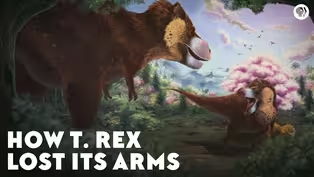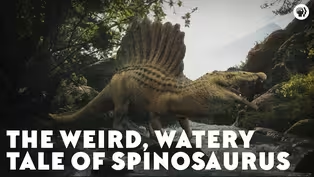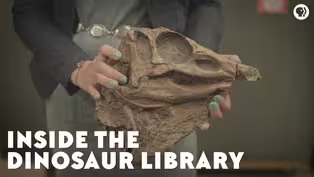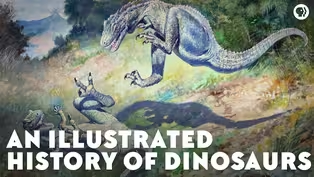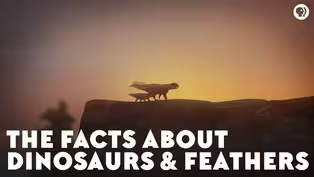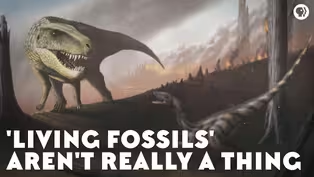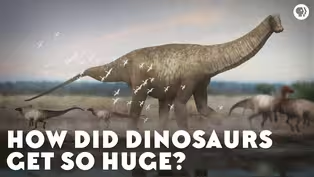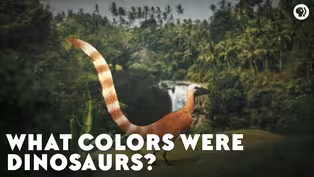
Stegosaurs: Tiny Brains & Thagomizers
Season 1 Episode 4 | 4m 49sVideo has Closed Captions
If you take it as a given that extinct dinosaurs were all weird and wonderful, then you go
If you take it as a given that extinct dinosaurs were all weird and wonderful, then you gotta at least consider that Stegosaurus was one of the weirdest and wonderfulest.
Problems playing video? | Closed Captioning Feedback
Problems playing video? | Closed Captioning Feedback

Stegosaurs: Tiny Brains & Thagomizers
Season 1 Episode 4 | 4m 49sVideo has Closed Captions
If you take it as a given that extinct dinosaurs were all weird and wonderful, then you gotta at least consider that Stegosaurus was one of the weirdest and wonderfulest.
Problems playing video? | Closed Captioning Feedback
How to Watch Eons
Eons is available to stream on pbs.org and the free PBS App, available on iPhone, Apple TV, Android TV, Android smartphones, Amazon Fire TV, Amazon Fire Tablet, Roku, Samsung Smart TV, and Vizio.
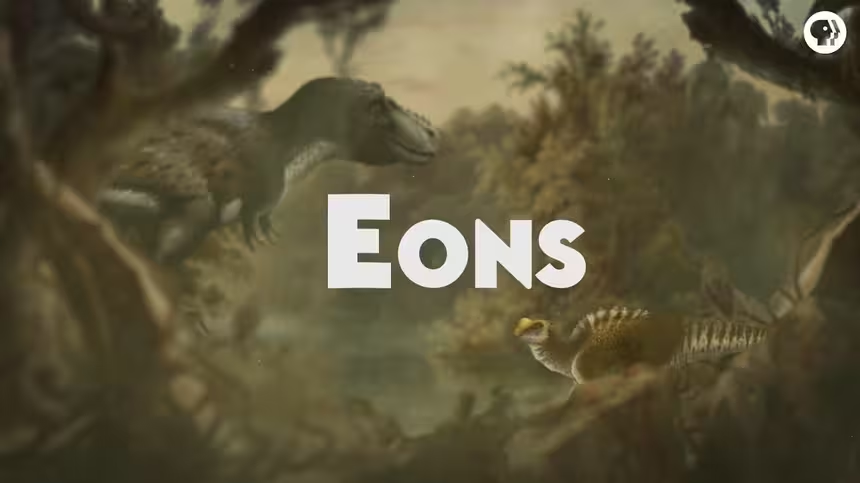
Welcome to Eons!
Join hosts Michelle Barboza-Ramirez, Kallie Moore, and Blake de Pastino as they take you on a journey through the history of life on Earth. From the dawn of life in the Archaean Eon through the Mesozoic Era — the so-called “Age of Dinosaurs” -- right up to the end of the most recent Ice Age.Providing Support for PBS.org
Learn Moreabout PBS online sponsorshipMore from This Collection
Eons videos all about Dinosaurs
Video has Closed Captions
Tyrannosaurus rex had tiny arms. How did this happen, and why did it keep them? (6m 54s)
The Weird, Watery Tale of Spinosaurus
Video has Closed Captions
In 1912, a fossil collector discovered the world’s only known semi-aquatic dinosaur. (7m 28s)
Video has Closed Captions
We talk to Amy Atwater, Collections Manager at the Museum of the Rockies. (7m 19s)
An Illustrated History of Dinosaurs
Video has Closed Captions
Our image of dinosaurs has been constantly changing since naturalists started studying the (12m 20s)
The Facts About Dinosaurs & Feathers
Video has Closed Captions
Dinosaurs have been found with some sort of fluff or even full-on plumage. (10m 1s)
Living Fossils' Aren't Really a Thing
Video has Closed Captions
Even the most ancient-looking organisms show us that evolution is always at work. (5m 5s)
How Did Dinosaurs Get So Huge?
Video has Closed Captions
Creatures as tall as a five-story buildings shook the Earth. (5m 42s)
Video has Closed Captions
We know a lot about dinosaurs but there’s one question that has plagued paleontologists.. (5m 2s)
Providing Support for PBS.org
Learn Moreabout PBS online sponsorshipIf you dig through your nearest toy box, you'll find some pretty familiar forms of ancient life.You got your Triceratops, your Tyrannosaur, and one of my personal favorites, the Pachycephalosaurus But you know one animal in here that doesn't quite belong?
The one that's doing its own thing?
The stegosaurus.
If you take it as a given that extinct dinosaurs were all weird and wonderful, then you gotta at least consider that Stegosaurus was one of the weirdest and wonderfulest.
Stegosaurus is the most recognizable genus of the stegosaurids, four-legged herbivores that sported bony plates and spiky spines on their backs, earning them the name that means "roofed lizard."
But unlike the other dinosaurs you find in the toy box which lived in Cretaceous Period, stegosaurids hit their prime much earlier, in the Jurassic.
This is when some of the largest herbivores, like Diplodocus, roamed the Earth, while carnivores, like Allosaurus, had just come on the scene.
It was in this environment that Stegosaurus thrived, with the help of some awesome adaptations.
But in some ways, despite all that armor, it might have been under-equipped.
Because its brain was almost impossibly small.
Stegosaurus had the one of the lowest brain-to-body ratios of any known dinosaur.
The animal itself could grow up to 9 meters long -- about the size of a small bus -- but its brain was only about 60 square centimeters, the size of a puppy's.
And when I say that this was almost "impossibly small," what I mean is, for a century or so, some paleontologists actually thought that stegosaurus must've had a second brain ... ...iiiin its butt.
In the 1880s, Yale paleontologist O. C. Marsh found that some specimens of Stegosaurus had a big cavity in it sacrum, where the spinal column meets the pelvis.
And he figured, since the brain in the head probably wasn't doing very much, maybe Stegosaurus was getting some help from its -- for lack of a better word -- butt-brain.
This led to a pernicious myth that Stegosaurus had, if not an actual second brain, at least a separate bundle of nervous tissue that helped control its tail and legs.
We know now, of course, that Stegosaurus didn't have two brains.
And some experts think that cavity in its sacrum was actually used to store glycogen, the starchy compound that animals -- including you and me -- use to store energy.
And just because its brain was small, that doesn't mean Stegosaurus was stupid.
In fact, you didn't want to tangle with this thing.
Because: It had a secret weapon: the thagomizer.
That's the unofficial name for the dinosaur's spiky tail.
Not all stegosaurids had thagomizers, but for those that did, like Stegosaurus and Kentrosaurus, fossil evidence suggests they were verrry effective weapons.
In 2014, the study of an Allosaurus fossil from Wyoming showed that its pubic bone had a puncture wound that matched the spikes on a stegosaur's tail.
Researchers concluded that the Allosaurus had attacked a Stegosaurus, which landed a blow right in the predator's groin.
The wound became so badly infected that it killed the Allosaurus, and the fossil record preserved what's probably the most gruesome groin shot ever documented.
Now, I'm sure you're wondering about the thagomizer's name.
Well, in 1982, Gary Larson's comic strip The Far Side depicted a group of cavemen getting a lesson in dinosaur anatomy.
And it shows the weaponized tail of the stegosaurus, labelled as a "thagomizer," quote, "after the late Thag Simmons."
Ok I know what you're going to say, cavemen and dinosaurs did not live at the same time, but the point is, the name stuck.
By the 1990s, paleontologists actually started referring to this tail feature as a thagomizer.
And when I interviewed Dr. Robert Bakker, the researcher who studied the Wyoming Allosaurus, he assured me that thagomizer is an accepted term for a stegosaurid's spiky tail.
Now, by far the most recognizable parts of a stegosaurid are the bony plates along its back, often called scutes.
Not "scutes" by the way, I looked it up...scutes And if you want to start a real, brawl among a bunch of paleontologists, just ask them what those scutes were for.
Because, they are still some of the most hotly debated features in dinosaur physiology.
For a long time, it was argued that the scutes were there for thermoregulation.
In the 1970s, researchers found tubes running through some fossilized scutes, and thought that they may have circulated blood through the plates to radiate heat.
But not everyone agrees with this.
Some experts have pointed out that not all stegosaurids have a full array of scutes, so if they did give them some advantage, they would be more common.
Others have noted that the tubes don't actually run all the way through the plates, which they would do, if their job was to circulate blood.
Now you might also think that the scutes were defensive.
But if that were the case, some experts have asked why they only appear along the back, and not on the sides or the skull?
The most recent theory is that stegosaurs had scutes because ... they just looked awesome.
After all, modern-day birds have made a very good living by having lots of features that are just for display.
So why couldn't the same have been true for extinct dinosaurs?
In 2005, a paper from Berkeley suggested that the plates helped the dinosaurs tell one species from another.
Ten years later, another study from Princeton proposed that the plates were even sex-specific, with females having tall, skinny plates, while males sported bigger, broader ones.
But, again, not everyone agrees.
What I think everyone can agree on is that stegosaurids are famous for good reason.
They might not have had the biggest brains, but they cut a distinctive figure back in the Jurassic, with their scutes and their spiky tails, which they knew how to use.
What do you want to know about the story of life on Earth?
Let us know in the comments below.
And don't forget to go to youtube.com/eons and subscribe!
Now, do yourself a favor and check out some of our sister channels from PBS Digital Studios.
Your brain will thank you!


- Science and Nature

A documentary series capturing the resilient work of female land stewards across the United States.












Support for PBS provided by:

